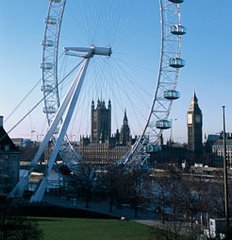go for all sightseeing.
It's with this in mind that I start what will become a regular(ish) series: Lunch time landmarks. The title's pretty self-explanatory really. I shall go to and write about landmarks that can be visited during lunch time. There are a few stipulations: the landmark must be in an area with a good number of businesses, so nothing too suburban or hidden away in a residential area; it must be easy to get to, with no wasting of time getting to hard-to-reach places; it must be free; and it must doable within an hour or less. Ideally it will also be close to a few cafes where our intrepid lunch-time tourists can grab a bit to eat. First up:
Piccadilly Circus
Or the statue and fountain that grace Piccadilly Circus to be more precise. In the heart of theatreland, Piccadilly Circus was built in 1819 to connect Regent Street (then under construction under the auspices of architect John Nash) with Piccadilly. Circus (from Latin, meaning circle) means a circular space at a road junction, so it seems this is one circus where there has never been animals. The space lost its circular shape in 1886 with the construction of Shaftesbury Avenue, so it's not a proper circus in either meaning of the word anymore.
But that does quite neatly lead us to the statue and fountain. The aforementioned avenue was named for one Anthony Ashley Cooper, the seventh earl of Shaftesbury, and the fountain and statue are a memorial to him. The earl was a big-hearted chap and the memorial is to commemorate his philanthropic works. The Shaftesbury Monument
Memorial Fountain, to give it its full name, was erected in 1892-1893, eight years after the earl's death.

Love God: Not Eros, and apparently not Richard Armitage either
The bronze fountain is topped by Alfred Gilbert's aluminium statue. This metal was somewhat rarer than it is today and the statue was the first in the world to be cast in it. This nude, butterfly-winged archer is popularly, though wrongly, called Eros. It was actually intended to be Eros's brother, Anteros, the god of selfless love and
much more appropriate to the charitable, and sober, earl than his more sensuous twin.
The statue was criticised as being in a vulgar part of town - theatres are full of wrong'uns you know. It was also considered too sensual for the famously repectable earl. It's from this that the statues other erroneous name comes from: to allay these objections the statue was renamed the Angel of Christian Charity. The new name didn't stick though, and neither did the correct name and the statue is known the world over as Eros.

Night light: Some of the world's biggest brands up in lights
Piccadilly Circus is one of the most visited sites in London, with scores of people meeting by the memorial. While you're here on your lunch time visit, and maybe pondering the appropriateness of a nude figure in such a public place as no doubt our Victorian predecessors did, take the time to check out the huge neon advertising boards, the Grade II listed Criterion Theatre, the London Pavilion and the huge Virgin Megastores at 1 Piccadilly.

1 comment:
I'd always thought it was Eros - thanks for putting me straight!
Post a Comment